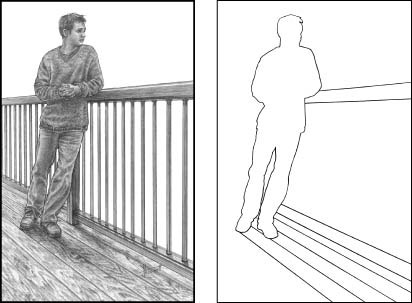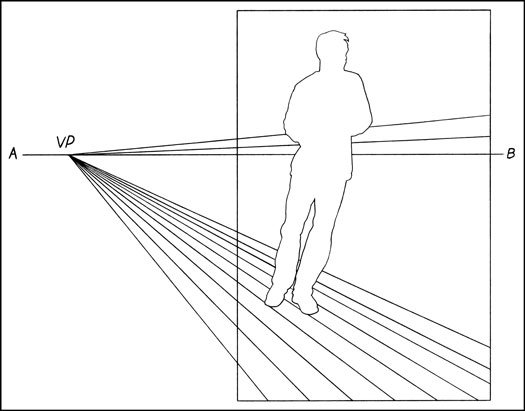Figure 2: An eye-level perspective — all angular lines converge at the same vanishing point.
Finding vanishing points
When an object's perspective lines recede into a properly placed vanishing point, your drawings appear more three-dimensional and visually correct. Finding and properly placing a vanishing point allows you to draw your subjects more realistically and in proper perspective.
Finding the vanishing point in a photograph or sketch
Many artists work from photos, without realizing that a camera lens can sometimes visually distort a scene. This may not be a problem when drawing landscapes. However, if you have human-made objects in your scene, such as buildings, stairs, or other objects with horizontal lines, you need to find the vanishing point and use geometric perspective to make them look visually correct.
The following steps explain how you can find a vanishing point in a photograph or sketch. These basic principles also apply to rendering a final drawing from one of your rough sketches.
Find an image that includes a level, man-made object with horizontal lines, such as a railing, deck, or wharf, or the roof, horizontal siding, or steps of a building. Then follow these steps:
1. Find an object in the image that you know is level and has more than one horizontal line.
In Figure 3, the horizontal lines on the edge of the railing and the wooden planks in the deck are level.
2. Tape a piece of tracing paper over the entire image.
3. With a pencil and a ruler, outline the upper and lower horizontal edges of this object, as well as any other lines that you know to be parallel, such as railings, decks, or the upper and lower edges of doors and windows.
Look at the outlines of the upper and lower edges of the railing and some of the spaces between the boards in the second drawing in Figure 3.
>

Figure 3: Tracing the outlines to find the vanishing point.
4. Tape your traced drawing to a larger sheet of drawing paper, leaving room to extend the horizontal lines of the object.
Refer to the lines on your tracing and take note of the direction in which they point. You can visually identify which lines are going to eventually converge.
Tape only the outer edges so that the tape doesn't tear the center area of your drawing paper when you remove it.
5. Use your ruler and a pencil to extend all of the horizontal lines until they meet.
Keep your lines light, so you can erase them later. Note the point where most lines converge. This is your vanishing point, which is located on the horizon line.
When an object has only one vanishing point, its perspective is referred to as one-point perspective.
6. Draw a straight line (the horizon line) through the vanishing point, horizontal to the top and bottom of your drawing paper.
Figure 4 shows the location of the vanishing point and the horizon line (Line AB).
7. Remove your tracing, redraw the lines of the object using the vanishing point as a guide, and complete your drawing.
>

Figure 4: Extending the horizontal lines until they converge at the vanishing point.
Sometimes you can see more than one side of an object, such as a building. If the angle (or corner end) of the building is closer to you than one of its sides, you need to use this same method to locate the second vanishing point (this is called two-point perspective). Horizontal lines on other visible sides of this object also converge at vanishing points somewhere on the same horizon line.
Finding a horizon line and vanishing point in real life
To identify the horizon line in an actual scene, mark it with your eye level. Remember — your eye level and the horizon line are one and the same. Look straight ahead, and the horizon line is in front of you.
Some clues for finding a vanishing point in a real setting include the following:
- A building or object with horizontal lines provides a perfect clue. Follow the same procedure as in "Finding the vanishing point in a photograph or sketch" earlier in this article. However, instead of drawing the lines, you simply eyeball them to find the approximate position of your vanishing point. Then you mark it in your drawing.
- Two parallel lines of the edges of straight roads, railway tracks, and fences can lead you to the vanishing point.
>
dummies
Source:http://www.dummies.com/how-to/content/drawing-geometric-perspective.html
No comments:
Post a Comment